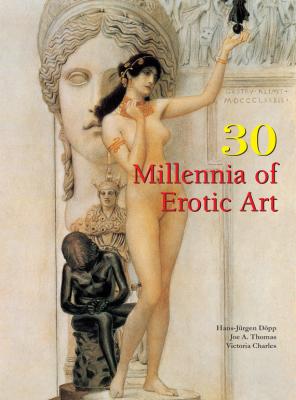30 Millennia of Erotic Art. Victoria Charles
Читать онлайн.| Название | 30 Millennia of Erotic Art |
|---|---|
| Автор произведения | Victoria Charles |
| Жанр | Изобразительное искусство, фотография |
| Серия | 30 Millennia |
| Издательство | Изобразительное искусство, фотография |
| Год выпуска | 2017 |
| isbn | 978-1-78310-333-1 |
The Hellenistic phase of Greek art was characterised by drama and emotion. The Barberini Faun (fig. 61) is a representation of a sensual spirit. Part goat, the figure expresses animal sexuality and allegiance to Dionysus, which is reflected in its apparent intoxication. The Venus de Milo (fig. 70) is the most famous and graceful of all depictions of Aphrodite. In Italy, the Etruscan civilisation adapted many Greek ideas, but accorded higher social status to women. Etruscan sarcophagi often displayed couples (fig. 21), and sometime painted decorations which depicted sexual activity. The Romans also followed and imitated Greek culture. Mansions rediscovered in the 18th century in the buried cities of Pompeii and Herculaneum reveal the rich sexual, and often humorous culture of the Romans. Brothels used erotic scenes to advertise or decorate their interiors. Gay themes were also not uncommon, such as the Warren Cup (The British Museum, London) which shows two male couples engaged in an erotic game, while sculptures glorifying Antinous, the young lover of Emperor Hadrian, abounded under the Empire (fig. 98). Although belonging to a greater tradition of realism, the treatment of the body in Roman art owed much to Greek heritage, and for centuries to come both Greek and Roman models represented an ideal for art and culture.
2. Anonymous, Rhombic Body of a Woman, c. 26,000–18,000 BCE.
Palaeolithic. Green steatite. Private collection.
3. Anonymous, The Venus of Lespugue, c. 26,000–24,000 BCE.
Palaeolithic. Curtains Cave, Lespugue (France). Mammoth ivory, 14.7 × 6 × 3.6 cm. Musée de l’Homme, Paris.
4. Anonymous, Venus Monpazier, c. 23,000–20,000 BCE.
Palaeolithic. Height: 5.5 cm. National Archaeological Museum, Saint-Germain-en-Laye.
5. Anonymous, The Venus of Willendorf, c. 30,000–25,000 BCE
Paleolithic. Limestone with red polychromy, height: 11.1 cm. Naturhistorisches Museum, Vienna.
Discovered in 1908 in the town of Krems, Lower Austria, the Venus of Willendorf is a limestone statuette dating to the Gravettian era. It represents a nude standing woman with steatopygous forms. The head and face, finely engraved, are completely covered and hidden by what appears to be coiled braids. Traces of pigment suggest that the original sculpture was painted in red. In fact, this statuette is the most famous example and one of the oldest sculptures of the Palaeolithic prehistory named by modern pre-historians “Venus”. Indeed, the corpulence of her body (breasts, buttocks, abdomen and thighs) can easily be equated to the symbols of fertility, the original feature of femininity, of which Venus has, since antiquity, been the pure incarnation. However, the interpretation of these works remain enigmatic and cannot really be verified. Some say statuettes of Venus were part of a religious cult, for others they were the “guardians of the home” or, more simply, the expression of an “ideal of Palaeolithic beauty”.
6. Anonymous, Venus of Laussel, c. 20,000–18,000 BCE
Paleolithic. Limestone, 54 × 36 × 15.5 cm. Musée d’Aquitaine, Bordeaux.
7. Anonymous, Mating, c. 5,000–3,000 BCE.
Neolithic. Aouanrehet (Algeria). In situ.
8. Anonymous, Reclining Female Figure, c. 2,400–2,300 BCE.
Paleolithic. Naxos (?) (Greece). White marble, 36.8 × 11.3 × 3.2 cm. The Menil Collection, Houston.
9. Anonymous, Statuette of a Snake Goddess, c. 1,600–1,500 BCE.
Gold and ivory, height: 16.1 cm. Museum of Fine Arts, Boston.
10. Anonymous, Statuette of Nefertiti (side view and front view), c. 1,570–1,320 BCE.
Ancient Egyptian (18th dynasty). Tell el-Amarna (Egypt). Limestone, height: 40 cm. Ägyptisches Museum, Berlin.
11. Anonymous, Woman’s Body (perhaps Nefertiti), c. 1,345–1,337 BCE.
Ancient Egyptian (18th dynasty, reign of Amenhotep IV, or Akhenaten). Silicified sandstone, height: 29 cm. Musée du Louvre, Paris.
12. Anonymous, Akhenaten with the Queen or a Princess, c. 1,570–1,320 BCE.
Ancient Egyptian, (18th dynasty). Limestone, height: 39.5 cm. Egyptian Museum, Cairo.
13. Anonymous, Relief of Humbaba, first half of 2nd millennium BCE.
Ancient Near East, Mesopotamia. Moulded terracotta. Musée du Louvre, Paris.
14. Anonymous, Prehistoric Version of the Kiss, c. 1,000 BCE.
Bronze Age. Vitlycke Rock Carvings near Tanum (Sweden). In situ.
15. Anonymous, The Cosmic Union of Geb and Nut (detail from an Egyptian papyrus), c. 1,025 BCE.
Ancient Egyptian. Vignette, 53 × 93 cm. The British Museum, London.
16. Anonymous, The Sounion Kouros, c. 600 BCE.
Ancient Greek. Marble, height: 305 cm. National Archaeological Museum of Athens, Athens.
17. Anonymous, Kleobis and Biton, c. 610–580 BCE.
Ancient Greek. Apollo Sanctuary, Delphi (Greece). Marble, height: 218 cm. Archaeological Museum of Delphi, Delphi.
Kleobis and Biton are life-size statues that were found in the sanctuary at Delphi. An inscription identifies the artist as coming from Argos, on the Peloponnesus. The sculptures’ origin in Argos links them to the mythical twins Kleobis and Biton. These young men from Argos were said to pull a cart a full five miles in order to bring their mother to a festival dedicated to the goddess Hera. In return, Hera granted the men what was seen as a great gift: a gentle death while sleeping. The brothers fell asleep after the festival and never woke up. Their great strength, devotion to their mother, and their early deaths were memorialised in dedicatory statues offered at the great sanctuary at Delphi, according to the historian Herodotus. These statues, which may be those described by Herodotus, are close in date to the Dipylon Head and share the same Egyptian style and decorative, incised details.
18. Anonymous, Kouros, known as Apollo from Tenea, c. 560–550 BCE.
Ancient Greek. Marble, height: 153 cm. Glyptothek, Munich.
19. Anonymous, Kouros of Kroisos, c. 530 BCE.
Ancient Greek. Anavyssos, Attica. Marble, height: 194 cm. National Archaeological Museum of Athens, Athens.
20. Anonymous, The Kritios Boy, c. 480–470 BCE.
Ancient
